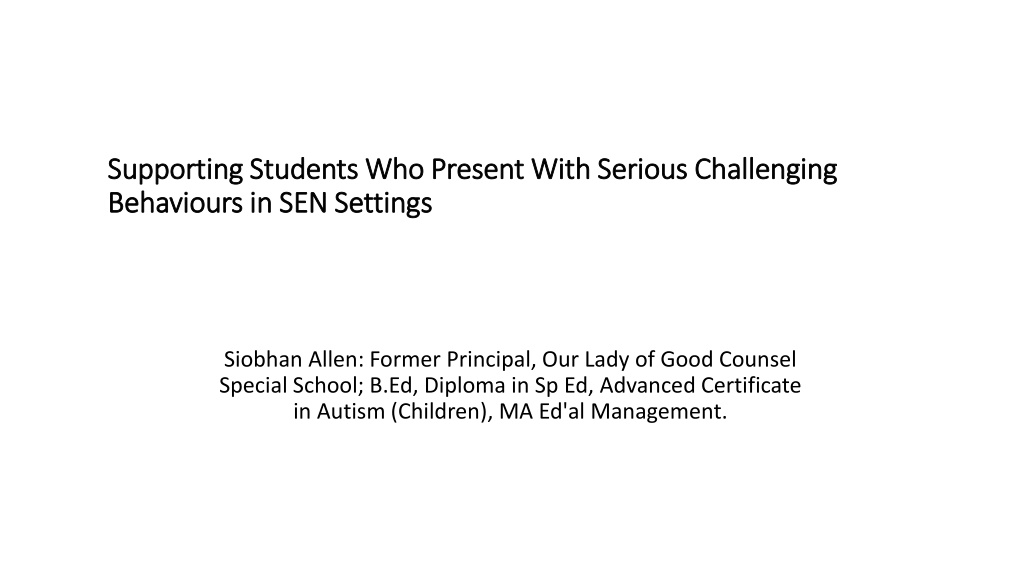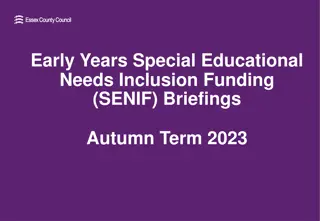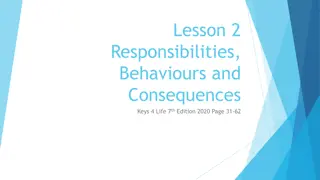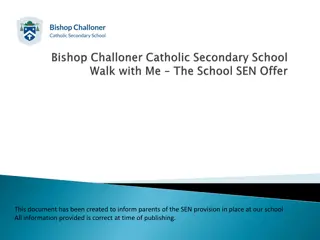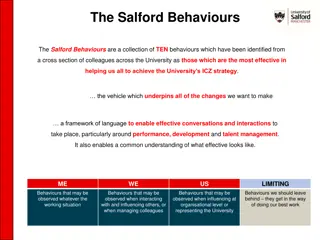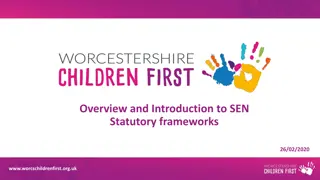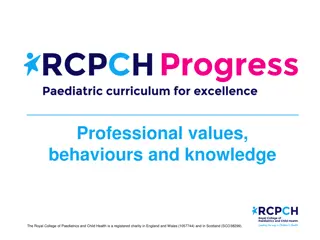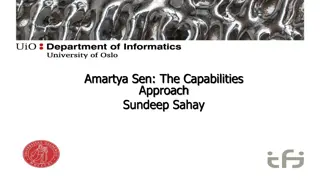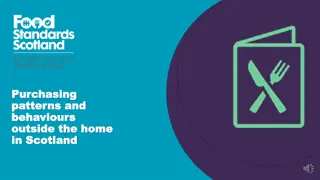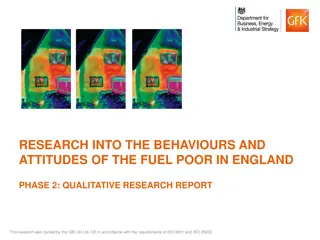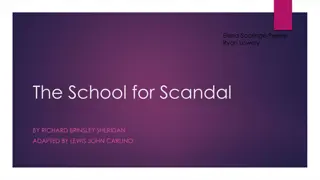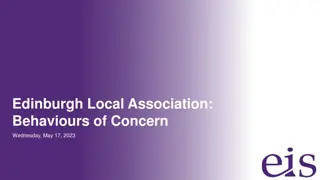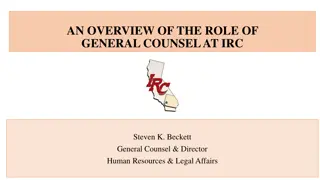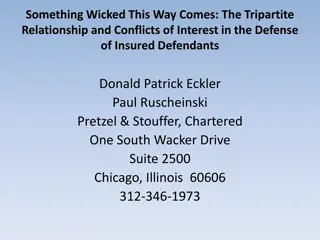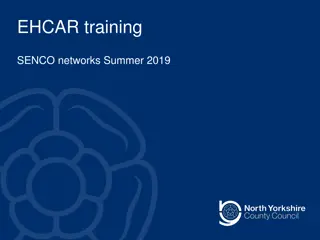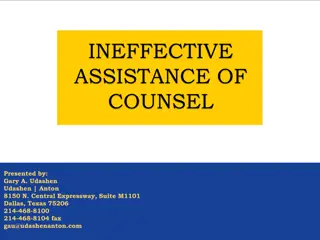Supporting Students with Challenging Behaviours in SEN Settings - Insights from Our Lady of Good Counsel Special School
Siobhan Allen, a former principal, shares experiences from Our Lady of Good Counsel Special School, focusing on supporting students with serious challenging behaviours in SEN settings. The school, established in 1957, provides educational services to students with moderate to multiple disabilities. Facing safety concerns and disruptions to teaching and learning, the school implemented various strategies like additional support, rearranging classes, and developing individualized education plans. Challenges persisted with a sub-group of students, leading to incidents of violent behaviours and staff resorting to restrictive practices. The narrative highlights the journey towards enhancing support for these students and fostering a safe learning environment.
Download Presentation

Please find below an Image/Link to download the presentation.
The content on the website is provided AS IS for your information and personal use only. It may not be sold, licensed, or shared on other websites without obtaining consent from the author. Download presentation by click this link. If you encounter any issues during the download, it is possible that the publisher has removed the file from their server.
E N D
Presentation Transcript
Supporting Students Who Present With Serious Challenging Supporting Students Who Present With Serious Challenging Behaviours in SEN Settings Behaviours in SEN Settings Siobhan Allen: Former Principal, Our Lady of Good Counsel Special School; B.Ed, Diploma in Sp Ed, Advanced Certificate in Autism (Children), MA Ed'al Management.
A parent once said to me If you can t help then who can?
Our Lady of Good Counsel Special School Estb. circa 1957 moved to new premises 2002 Moderate Learning Disability - historically relatively homogenous group 68 students aged 4 to 18 - of which 42 diagnosed with multiple disabilities A number of students present with high or very high support needs in terms of behaviours which present dangers to themselves or others Multi-Disciplinary Support from the Brothers of Charity
10 years ago Teaching and learning for almost all pupils significantly affected Safety concerns re pupils and staff Suspensions/alterations to length of school day were occurring School management felt very vulnerable
How Did We Respond? Applied for additional teacher and SNA support Rearranged classes Physical Environment Support of professionals from various sources Developed IEPS and BSPs Looked at our general curriculum Looked at our teaching methodologies/strategies
However Did not adequately support a sub group (2-3 students) Serious incidents involving violent behaviours continued Teaching and learning continued to be disrupted Staff reported lacking direction/confidence Increasingly staff found themselves beginning to use restrictive practices/physical interventions to keep pupils and staff safe in emergency situations
Then some significant things happened. School Self Evaluation Process Comment of Parent Child Protection/Anti-Bullying
WE ASKED: What is really happening in our school in relation to physical interventions? Do we have procedures and policies to guide staff?
Curriculum Reassurance/ Comfort Intimate Care/Safety /First Aid Non-Contact restrictions/ containment Use of force P.E Pat on arm for praise/ attention Cleaning cuts High handles on some doors Disengaging from a grab/hair pull/bite Drama/Music Holding hand of upset child Lifting a child from a height Coded access/locks to prevent access Transitioning an unwilling child to a safer place Physical Prompts Hand over hand High Fives/Hugs Toileting Harnesses on transport Breaking up a fight/removing a weapon Sensory Programmes Sitting on laps? Dressing (swimming) Fences around yards with padlocks Restraint/ Isolation/seclusion
We Asked: What Do We Want Our Children to Experience In School? Care Safety Dignity Respect Skilled Staff Education Entertainment
What Did We Do? Sourced training Sourced training Trained Trained tutors tutors Developed a pupil Developed a pupil s support team/area which upport team/area which could operate independently of the rest of the school when independently of the rest of the school when required could operate required Began the process of developing highly individualised, Began the process of developing highly individualised, personalised programmes in terms of environment, personalised programmes in terms of environment, timetable, curriculum (proactive) and planned responses timetable, curriculum (proactive) and planned responses to behaviours (reactive). to behaviours (reactive). Focussed on communication and Focussed on communication and prevention prevention Began the process of developing our own policies, Began the process of developing our own policies, procedures and guidance procedures and guidance
Learned the Principles of Best Practice Punishment/sanction/convenience always unlawful Safety and welfare of children must be centre stage Is what we are doing in the best interests of the child? Last resort planned de-escalation, diffusion, diversion Maximum care/minimum restrictive practices not routine Reasonable, proportionate and necessary
Implemented Principles of Best Practice Researched and developed our own policy Developed our own system of oversight with the BOM- monitored, reviewed, reported at BOM Consulted with psychologists, SLTs, OTs and Social Workers Positive Behaviour Plans (Risk Reduction Plans) agreed with parents and multi-disciplinary team personalised and individual Multi-Element approach function, skills teaching, prevention, direct intervention, mood management
What Changed? Increased levels of confidence amongst the school community to discharge their duty of care to all pupils Developed skills of diversion, diffusion and de-escalation Situations were resolved most of the time without the need for physical intervention reducing all the time Clear guidance/strategies to reduce risk where it was foreseeable that a physical intervention was necessary to safeguard the safety of self or others
Current Situation? Schools still waiting for governmental guidance and oversight Reports of bad practice are leading to media attention - highlighting the issue and/or fuelling the fear? Morale an issue in schools struggling to manage
Lack of guidance leads to confusion which fosters bad practice by staff and distrust by parents
Good guidance directs towards best practice and fosters confidence (staff and parents)
The Reality For Schools Schools cannot avoid using physical contact physical interventions/restrictive practices are part of the solution to keep children and staff safe in emergency situations involving violence Risks cannot be eliminated but they can be reduced and managed High support pupils need a wraparound, intensive, multi disciplinary response from the system (education, welfare and health) supporting not only school but home as well
REALITY Most schools at ground level are trying to develop and provide individualised responses tailored to these childrens highly specific needs Trying their best to keep the pupils in school Staff dealing with complex, high intensity, high risk situations too often Resources such as staffing, space, support, time to plan stretched to upper limit BOM safety, welfare, administrative, financial burden Challenge of inclusion with other pupils
A lot has been done by various groups SESS, NCSE, IPPN, INTO, CPMSE, NABMSE, Inclusion Ireland and others
BUT FOR THIS GROUP OF PUPILS Schools need to be better supported by the system in terms of lawful policy guidance and training for staff Pupils need flexible, sensible, integrated, personalised resource allocation URGENT, emotional, complex issue requiring a measured response from all Education Partners
If you cant help, then who can? If you can t help, then who can?
